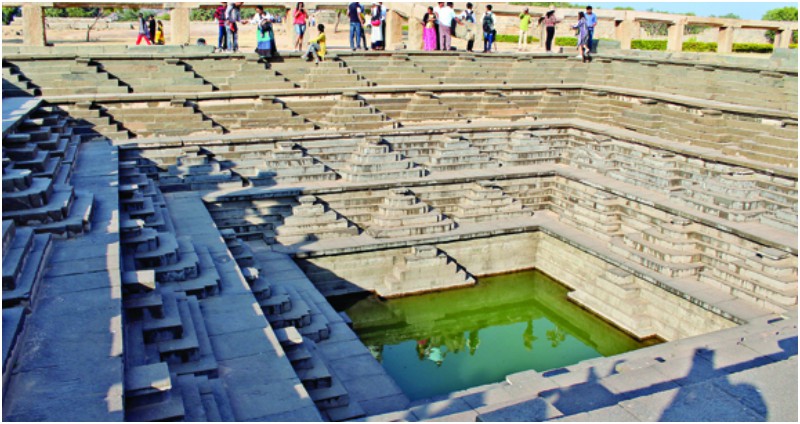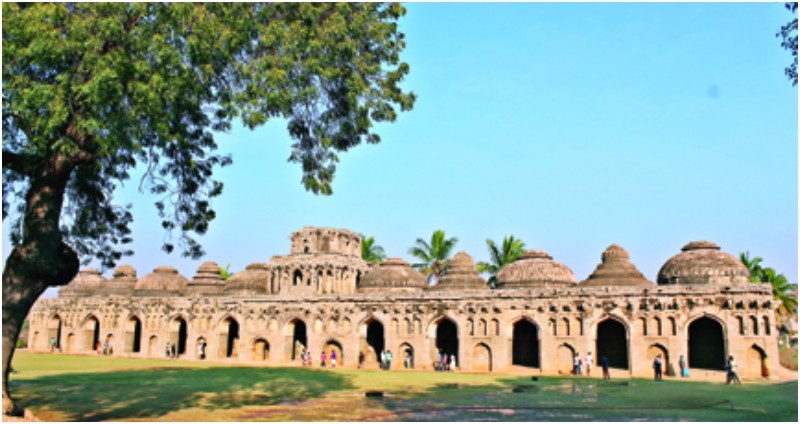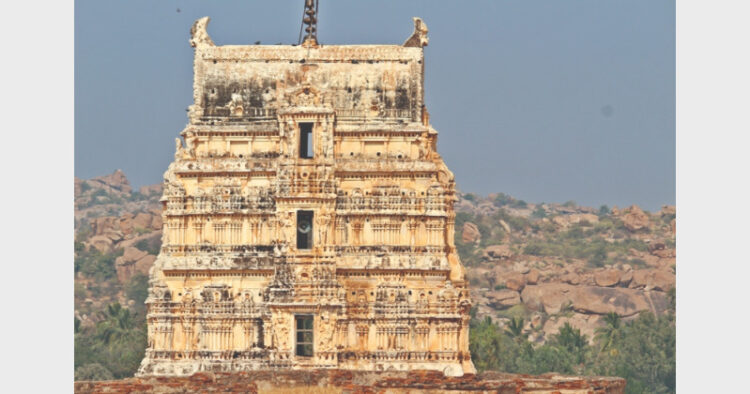Culture Travelogue
Almost every cranny of Hampi has a tale to tell, every crevice has a secret to spill. Just listen intently—it is Hampi

Hampi the capital of the Vijayanagara empire which flourished in the 14th century, is located in modern-day Bellary district of Karnataka. Hospet is the nearest railway station. The ruins of the city are spread over approximately 4100 hectares.
Learning a little history before visiting Hampi can be advantageous, else all that you would see would be mere rocks.
Vijayanagara Empire
Hampi should be visited to know the story of the battles from the scattered debris and should realise the cruelty of the sultans from broken idols.
Kampili was a small kingdom where people lived very happily until Tughlaq marched in and beat them through in a brutal war. Frightened women committed suicide. The Vijayanagar city was built above the ruins of the same Kampili.
Vijayanagara can be defined as a divine aesthetic with Temples, ponds, magnificent carvings, palaces, attractions, attractions, and commercial places. The Vijayanagara empire was ruled by four dynasties.
1. The Sangama dynasty
2. The Salwa dynasty
3. The Thuluva Dynasty
4. The Aravadu dynasty
Hakka, Bhukka and Devarayanans ruled the kingdom and the Mughal Bahmani Sultans were separated by war strategies. The size of the empire increased with a number of victories. The Salwa dynasty too followed this. The Salwa Dynasty withdrew when the country was not able tomove much further without long-term perception.
The Tuluva Dynasty ruled the Vijayanagara after that. Krishna Devarayar, the proud King of the dynasty, provided security for women, reduced tax liability of the people, implemented developmental activities, promoted art and literature, and respected all beliefs and religions. He had the power to defeat any enemy army. With Tenali Raman beside him, he befriended enemy’s enemies to defeat his enemies.
The daily routine of Krishna Devarayar was popular. After drinking some oil, then the whole body will be smudged with oil and exercise until the oil is sweated out followed by horse ride and bath. His day of governance would start only after prayers.
Hampi will not disappoint you. Hampi is a haven for archaeology aficionados and a place to nestle and engage in some introspection
Devarayar fought against the Bijapur Sultan. The war was a warning that the Vijayanagara Empire was capable of defeating the Muslim invasion. When his army retreated, he fought with pride and won Raichur. Devarayar could never be beaten with tricks. He passed away in 1529. Later Achuthan Devarayar and Sadasiva Devarayar ruled the country. This period was an opportunity for the enemies to strike. Deccan sultans, who were separated till then, joined together and destroyed the Vijayanagara. Later, the Arvindu Dynasty ruled the Vijayanagara, but couldn’t take it back to its glorious days. Thus the empire was completely destroyed.
Hampi should be visited at least once. We need to know the story of the battles from the scattered debris, should know the ancestors through the sculptures, and should realise the cruelty of the sultans from broken idols. As you go there, you would feel the burning pride in your heart.
Anjanadri Hills
If you cross the Tungabhadra River, which is behind the Virupaksha Temple, you will reach the Hippie Island. Anjanadri Hills is located just 4 km away from Hippie Islands. Kishkindha, the place, which is mentioned in the Ramayana, is located in Hampi. One must climb up to five hundred seventy steps to reach there. At the summit, there is a small temple dedicated to Lord Hanuman. According to Hindu mythology, Lord Hanuman was born to Anjana. Thus Hanuman is also known as Anjaneya and his birthplace as Anjanaadri hill. Also, the small shrine for Rama and his consort Sita are installed inside the temple. The tourists’ come here to view the sunset and the sunrise. The view from the hilltop is marvellous. It has a certain vibe, charm.
Virupaksha Temple

This temple is located on the south bank of the river Tungabhadra, just next to where the local bus drops you. Queen Lokamahadevi, the chief wife of the king, Vikramaditya II, led the construction of the temple to the Hindu god Shiva during the early Chalukya dynasty, around 733 AD to commemorate her husband’s victory over the Pallavas. The temple was later renovated by Krishnadevaraya. The Virupaksha temple is built in the Dravidian style of architecture. The queen had a prominent place in the temple’s iconography.
The east facing giant tower (Gopura) leads you to the first courtyard of the temple complex. This pastel painted 9 storied towers with a pair of cow horn-like projections on top is the most prominent landmark in Hampi. The sanctum contains the idol of Lord Virupaksha in the form of a Linga. The most important of the sub- shrines are that of Goddess Pampa and Bhuvaneswari, consorts of Lord Shiva, towards the north of the main shrine. There are stories from Ramayana, Mahabharata, and the Bhagavad Gita carved on the walls of the temple. You can witness the daily temple rituals and ceremonies in the mornings and evenings.
The annual festival celebrated in February every year, attract huge crowds of tourists and pilgrims.
Vittala Temple
The Vittala Temple complex is considered the “jewel in the crown” of Hampi’s architectural beauty. The Vittala Temple in Hampi is an ancient monument that is well-known for its exceptional architecture and unmatched craftsmanship. It was built during the reign of King Devaraya II. The iconic temple has amazing stone structures such as the incomparable stone chariot and the fascinating musical pillars. The temple is dedicated to Lord Vittala, an incarnation of Lord Vishnu. An idol of Vittala-Vishnu was enshrined in the temple. However, now the sanctum is devoid of any idol.
The temple exemplifies the immense creativity and architectural excellence of the sculptors and artisans of the Vijayanagara era. Notable among these structures are the shrines of the Goddess, Maha Mantapa, Ranga Mantapa, Kalyana Mantapa, Utsava Mantapa, and the famous Stone Chariot. The Stone Chariot is actually a shrine that has been designed in the shape of an ornamental chariot. The shrine is dedicated to Garuda and has an image of Garuda enshrined at the sanctum.
The Ranga Mantapa is one of the main attractions of the Vittala Temple. The large mantapa is renowned for its 56 musical pillars. These musical pillars are also known as Saregama pillars, indicating the musical notes emitted by them. The musical notes and emanated when the pillars are tapped gently. The temple is a must-see for visitors.
Zenana Enclosure

The Zenana Enclosure was a fortified and secluded area reserved for the royal ladies of the Vijayanagara Empire. The enclosure is a sprawling compound that had tall walls surrounding it on all sides and watchtowers to keep guard against any trespassers. The enclosure initially had four watchtowers. But now, there are just three watchtowers which are located in the eastern, south-eastern and northern sides of the enclosure. The presence of these three watchtowers indicates that the enclosure was a protected area that offered privacy to the royal women of the Vijayanagara Empire, including the Queen. The structure of the Zenana Enclosure is designed in the Indo-Islamic style of architecture.
Lotus Mahal

The Lotus Mahal is otherwise called the Kamal Mahal or Chitragani Mahal. As the name given to the palace is because of the shape it resembles. Lotus Mahal is a two-storey, very symmetric structure exhibiting a fine example of Indo-Islamic architecture. The base of the structure depicts a Hindu foundation of stone just like in the temples, typical of Vijayanagara architecture while the upper superstructure is Islamic in architecture with pyramidal towers instead of regular dome shapes, giving it a Lotus-like look. The place is designed for royal ladies of those times to mingle around and enjoy recreational activities. The Mahal also served as a meeting point for the king and his ministers. It is said that the Queen of Krishna Deva Raya used to spend her most of the time seeking pleasure and peace in the palace. The adjoining gardens along the buildings, with trees around, serves as a viewing pod for tourists to sit and enjoy.
Elephant Stable

The Elephant Stable in Hampi is an impressive structure that was used to provide shelter for the royal elephants. There are in all eleven chambers of which some are interconnected. The centre chamber is specially decorated and quite huge. Probably the musicians and the band troupes had been using this during ceremonies involved in the processions of elephants. Elephants have always been termed as royal animals used by the kings and princess to fight and show as a wealth of the kingdom.
Hampi has plenty of great accommodation options but if you’re feeling adventurous, it is also a great place to camp at. Here you can set up tents and have fun.
Hampi will not disappoint you. Hampi is a haven for archaeology aficionados. This is the ideal place to nestle and engage in some introspection. Almost every cranny of Hampi is conducive for this. Every crack has a tale to tell; every crevice has a secret to spill. Just listen intently—it is Hampi.














Comments